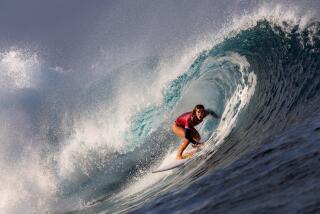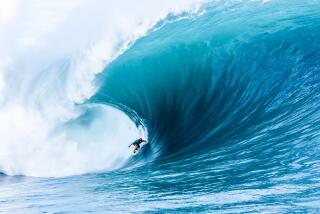Take a seat and ride the wave
- Share via
I first paddled a kayak on the cold Atlantic waters of Blue Hill, Maine. It was the summer of 1970, and my boat was a hand-molded fiberglass shell that left tiny needles of glass embedded in my knees and thighs.
My teacher, Homer Heller, had been kayaking for decades, and his love for the sport, its intricacies of balance and blade, made him an ideal instructor for an eager 18-year-old with more enthusiasm than talent.
In the white water of the incoming tide, he taught me how to ferry and lean away from the current, and he fished me from the froth when my Eskimo roll failed me, which, that summer, it always did.
Over the years, other sports pulled me into the mountains. Occasionally I’d run the Kern on a raft or a self-bailing inflatable, but I wanted more than an afternoon’s entertainment. I wanted to be a kayaker.
I turned to a new paddling mentor, Rob, for that. Neither fatherhood nor time has diminished his passion for risk. In a neighbor’s pool he revealed the secrets of the Eskimo roll, and then he guided me into the surf.
Gradually the terror in my belly subsided. I started to spend more time on the water than in it. My rolls began to stick. I learned to hold an edge inside the waves and turn with a flick of a paddle.
I was ready to head south from Santa Monica for a break made for kayak surfing: San Onofre.
At seven o’clock on a weekday morning, the sandy road along the shore of San Onofre is already crowded with cars, vans, pickups and campers. A stack of beautifully shaped long boards crowns the top of a pristine wood station wagon. I imagine Frankie and Annette stealing a kiss beneath the swaying palm trees.
At Old Man’s and Trestles, the breaks San Onofre is famous for, parents teach their kids to surf the same wave they learned on.
I’m ready for my next lesson. Mike Johnson, a burly former Olympian and now the designer of the Mako waveski, has offered to let me paddle one of his boards. The waveski originated in Australia, and Mike has been building them since the ‘70s.
In essence a surfboard with a shallow seat and Velcro straps for feet and thighs, the ski is popular with a growing cadre of locals -- including some handicapped paddlers -- at San Onofre. So popular that it has helped make the south end of the beach a “paddle only zone.”
Within minutes I’m wading into the water and strapping on one of his sleek, lightweight boards. To my right, a hundred surfers are packed together. In front of me, a dozen paddlers play like a familial pod of dolphins. Mike points to a red-lettered “O.K.” sign on the beach.
“That’s the boundary,” he shouts. “We stay south of the sign.” The waveski feels awkward and tippy to me. I miss the pressure of knees and hips, the quick response of my riverboat. The head-high swell breaks over the front of the ski and lifts me like a leaf. Mike yells directions. “Outside, outside.”
I see a slow-moving hump of water on the slate gray horizon.
“Paddle, paddle,” Mike screams. “You’ve got it, go, go.”
Mike’s voice fades in the oncoming roar. I paddle hard and find myself suddenly lifted up and forward. And then I am flying. And screaming. The face is steep and huge. It surges when it breaks, and I fly even faster.
When the wave is finally spent, some 200 yards down the beach, I’m flipped in the foam and come up grinning so hard my lips hurt. Mike sees me and laughs. “Not bad, huh?”
There may be tension between traditional surfers and kayakers, but I have yet to experience it at San Onofre. I’m careful to share the waves and keep my place in the lineup at this paddle-surf haven.
Now I’m saving for a custom waveski and remodeling the garage to store a growing collection of watercraft.
I’ve also learned some new moves and tricks on ocean swells that will keep me sitting down in the water for years to come.
More to Read
Sign up for The Wild
We’ll help you find the best places to hike, bike and run, as well as the perfect silent spots for meditation and yoga.
You may occasionally receive promotional content from the Los Angeles Times.






